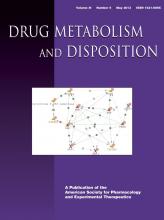Abstract
5-Methoxy-N,N-dimethyltryptamine (5-MeO-DMT or street name “5-MEO”) is a newer designer drug belonging to a group of naturally occurring indolealkylamines. Our recent study has demonstrated that coadministration of monoamine oxidase A (MAO-A) inhibitor harmaline (5 mg/kg) increases systemic exposure to 5-MeO-DMT (2 mg/kg) and active metabolite bufotenine. This study is aimed at delineating harmaline and 5-MeO-DMT pharmacokinetic (PK) interactions at multiple dose levels, as well as the impact of CYP2D6 that affects harmaline PK and determines 5-MeO-DMT O-demethylation to produce bufotenine. Our data revealed that inhibition of MAO-A–mediated metabolic elimination by harmaline (2, 5, and 15 mg/kg) led to a sharp increase in systemic and cerebral exposure to 5-MeO-DMT (2 and 10 mg/kg) at all dose combinations. A more pronounced effect on 5-MeO-DMT PK was associated with greater exposure to harmaline in wild-type mice than CYP2D6-humanized (Tg-CYP2D6) mice. Harmaline (5 mg/kg) also increased blood and brain bufotenine concentrations that were generally higher in Tg-CYP2D6 mice. Surprisingly, greater harmaline dose (15 mg/kg) reduced bufotenine levels. The in vivo inhibitory effect of harmaline on CYP2D6-catalyzed bufotenine formation was confirmed by in vitro study using purified CYP2D6. Given these findings, a unified PK model including the inhibition of MAO-A- and CYP2D6-catalyzed 5-MeO-DMT metabolism by harmaline was developed to describe blood harmaline, 5-MeO-DMT, and bufotenine PK profiles in both wild-type and Tg-CYP2D6 mouse models. This PK model may be further employed to predict harmaline and 5-MeO-DMT PK interactions at various doses, define the impact of CYP2D6 status, and drive harmaline–5-MeO-DMT pharmacodynamics.
Footnotes
- Received December 19, 2012.
- Accepted February 7, 2013.
X.-L.J. and H.-W.S. contributed equally to this work.
This research was supported by the National Institutes of Health National Institute on Drug Abuse [Grant R01-DA021172]. X.-L.J. was supported by a Pfizer fellowship.
- Copyright © 2013 by The American Society for Pharmacology and Experimental Therapeutics
DMD articles become freely available 12 months after publication, and remain freely available for 5 years.Non-open access articles that fall outside this five year window are available only to institutional subscribers and current ASPET members, or through the article purchase feature at the bottom of the page.
|






